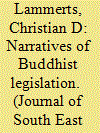| Srl | Item |
| 1 |
ID:
183014


|
|
|
|
|
| Summary/Abstract |
This paper uses the concept of totalism to analyze the main features of Islamic State and thus the implications of containing and confronting it and its potential future offshoots. The first part of the paper deals with the origins and concept of totalism, depicting its main features and types. This part begins by briefly showing the main features of totalism, why it must be ultimately differentiated from totalitarianism. The second part of the paper explores the extent to which Islamic State conforms to the model of a renovative totalist movement and why terms such as political religion are unsuited for explaining Islamist and Salafi-Jihadist movements, including Islamic State. Due to the overall direction of its ultimate ideological aims and the way in which it pursues the total reconstruction of public and private life, Islamic State is then found to contain the main features of a militant, renovative totalist movement. Lastly, the paper argues that it is primarily this totalist nature of the movement which, together with total commitment to emulating what it sees as the essential early Islamic traditions and examples, contributes to its long-term resilience even in the face of overwhelming odds and military reversals.
|
|
|
|
|
|
|
|
|
|
|
|
|
|
|
|
| 2 |
ID:
142709


|
|
|
|
|
| Summary/Abstract |
This paper examines the case of a Shiite practitioner of Tibetan medicine in Ladakh, North-western India. It recounts the story of a Buddhist family converted to Islam, for which the abandonment of religion has not led to the discontinuation of a lineal medical practice known to have Buddhist overtones. This situation provides an invitation to explore the social consequences of maintaining the practice in a region characterized by religious conflict, as well as the criteria of sameness and difference, technique and genealogy that make a marked ‘other’ a practitioner of Tibetan medicine. These religious overlaps are, however, not only apparent at the social level; they are also present in the preparation of medicines, in etiological narratives or in the physical regimes of bodily care. The composite nature of medical practice helps us to observe from a new angle the role of religion in the practice of Tibetan medicine. The way medicine is enacted and performed in this context provides empirical materials to study the paradigms that both structure and confer motion to Tibetan learned medicine. The ethnography of a remote region in the Himalayas opens up research paths for the anthropology of Asian medicine amongst new categories of healers and renewed contexts of practice.
|
|
|
|
|
|
|
|
|
|
|
|
|
|
|
|
| 3 |
ID:
137180


|
|
|
|
|
| Summary/Abstract |
This paper argues that the designation of heterodoxy for the socio-religious movements of late antique Iran such as Mazdakism is a misnomer. It suggests that the designation of Mazdakism and similar movements as heterodoxies is in fact the product of an early Islamic assessment of post-Sasanian Zoroastrian attempts to create a Zoroastrian orthodoxy which did not exist under Sasanian rule. Pressured by the Abrahamic religions surrounding them, the followers of Weh Dēn in this period felt the need to demarcate and clarify their beliefs, and to make their own beliefs comprehensible to their neighbors and rulers. What was then left out of this attempt was labeled a deviation, and heterodoxy, whose fundamental disagreement with Zoroastrian orthodoxy was then reflected back in time.
|
|
|
|
|
|
|
|
|
|
|
|
|
|
|
|
| 4 |
ID:
124275


|
|
|
|
|
| Publication |
2013.
|
| Summary/Abstract |
For more than a century scholars of central and western mainland Southeast Asia have sought to characterise the status of dhammasattha - the predominant genre of written law from the region before colonialism - and define its authority vis-à-vis Pali Buddhism. For some, dhammasattha texts represent a predominantly 'secular' or 'customary' tradition, while for others they are seen as largely commensurate with, if not directly derived from, the religio-political ideas of a cosmopolitan and purportedly canonical 'Therav?da'. However, scholarship has yet to investigate the way that regional authors during the late premodern period themselves understood the character and legitimacy of written law. The present article examines seventeenth through nineteenth-century Burmese narratives concerning the genealogy and status of dhammasattha to advance a pluralist conception of the relationship between law and religion in Southeast Asian history. This analysis addresses a historical context where ideas concerning Buddhist textual authority were in the process of development, and where there were multiple and competing discourses of legal ideology in play. For elite monastic critics closely connected with royalty, dhammasattha stood in problematic relation to authoritative taxonomies of scripture, and its jurisprudence was seen to contradict authorised accounts of the origin and nature of Buddhist law; the genre thus required reform to be brought into alignment with what were construed as orthodox legal imaginaries. The principal hermeneutic move these monastic commentators performed to achieve this involved redescribing dhammasattha in light of such accounts as a variety of Buddhist royal legislation and written law as the prerogative of the Buddhist state.
|
|
|
|
|
|
|
|
|
|
|
|
|
|
|
|